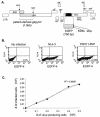Novel single-cell-level phenotypic assay for residual drug susceptibility and reduced replication capacity of drug-resistant human immunodeficiency virus type 1
- PMID: 14747537
- PMCID: PMC369469
- DOI: 10.1128/jvi.78.4.1718-1729.2004
Novel single-cell-level phenotypic assay for residual drug susceptibility and reduced replication capacity of drug-resistant human immunodeficiency virus type 1
Abstract
Human immunodeficiency virus type 1 (HIV-1)-infected individuals who develop drug-resistant virus during antiretroviral therapy may derive benefit from continued treatment for two reasons. First, drug-resistant viruses can retain partial susceptibility to the drug combination. Second, therapy selects for drug-resistant viruses that may have reduced replication capacities relative to archived, drug-sensitive viruses. We developed a novel single-cell-level phenotypic assay that allows these two effects to be distinguished and compared quantitatively. Patient-derived gag-pol sequences were cloned into an HIV-1 reporter virus that expresses an endoplasmic reticulum-retained Env-green fluorescent protein fusion. Flow cytometric analysis of single-round infections allowed a quantitative analysis of viral replication over a 4-log dynamic range. The assay faithfully reproduced known in vivo drug interactions occurring at the level of target cells. Simultaneous analysis of single-round infections by wild-type and resistant viruses in the presence and absence of the relevant drug combination divided the benefit of continued nonsuppressive treatment into two additive components, residual virus susceptibility to the drug combination and selection for drug-resistant variants with diminished replication capacities. In some patients with drug resistance, the dominant circulating viruses retained significant susceptibility to the combination. However, in other cases, the dominant drug-resistant viruses showed no residual susceptibility to the combination but had a reduced replication capacity relative to the wild-type virus. In this case, simplification of the regimen might still allow adequate suppression of the wild-type virus. In a third pattern, the resistant viruses had no residual susceptibility to the relevant drug regimen but nevertheless had a replication capacity equivalent to that of wild-type virus. In such cases, there is no benefit to continued treatment. Thus, the ability to simultaneously analyze residual susceptibility and reduced replication capacity of drug-resistant viruses may provide a basis for rational therapeutic decisions in the setting of treatment failure.
Figures







References
-
- Arribas, J. R., F. Pulido, J. M. Miro, M. A. Costa, J. Gonzalez, R. Rubio, J. M. Pena, M. Torralba, M. Lonca, A. Lorenzo, A. Del Palacio, J. J. Vazquez, and J. M. Gatell. 2002. High effectiveness of efavirenz-based highly active antiretroviral therapy in HIV-1-infected patients with fewer than 100 CD4 cells/μl and opportunistic diseases: the EfaVIP study (efavirenz in very immunosuppressed patients). AIDS 16:1554-1556. - PubMed
-
- Autran, B., G. Carcelain, T. S. Li, C. Blanc, D. Mathez, R. Tubiana, C. Katlama, P. Debre, and J. Leibowitch. 1997. Positive effects of combined antiretroviral therapy on CD4+ T cell homeostasis and function in advanced HIV disease. Science 277:112-116. - PubMed
-
- Barbour, J. D., T. Wrin, R. M. Grant, J. N. Martin, M. R. Segal, C. J. Petropoulos, and S. G. Deeks. 2002. Evolution of phenotypic drug susceptibility and viral replication capacity during long-term virologic failure of protease inhibitor therapy in human immunodeficiency virus-infected adults. J. Virol. 76:11104-11112. - PMC - PubMed
-
- Blankson, J. N., D. Persaud, and R. F. Siliciano. 2002. The challenge of viral reservoirs in HIV-1 infection. Annu. Rev. Med. 53:557-593. - PubMed
Publication types
MeSH terms
Substances
Grants and funding
LinkOut - more resources
Full Text Sources
Other Literature Sources

